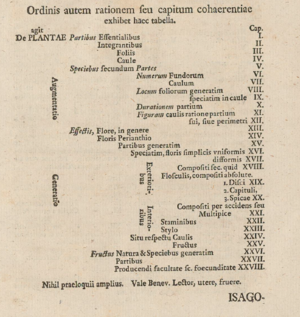Niklaas Görsch
The Age of Affinity: Diagrams in Natural History, 17th to early 19th Century
This project is part of the SNF Sinergia project "In the Shadow of the Tree: The Diagrammatics of Relatedness as Scientific, Scholarly, and Popular Practice". It is subdivided into four research groups at the universities of Luzern, Zürich, Basel and Lübeck.

A key development in early modern natural history that so far has received very little attention from historians of science is the introduction of various dichotomous and tabular diagrams to illustrate classifications of plants and animals towards the end of the seventeenth century, culminating in the popularization of Linnaeus' System of Nature (1735), especially his sexual system of plant classification, in the eighteenth century. While initially these diagrams seem to have served purposes of species diagnosis and identification only, a first debate emerged around 1700 about whether they were able to capture "natural affinities" and, in particular, serve as guides towards medical and other useful properties of plants. This debate continued throughout the eighteenth century and finally led to the strict distinction between dichotomous keys on the one hand and the 'natural system' on the other, which was now preferably visualized as a map or network. While some literature exists about the practices behind such diagrams, like the collection and exchange of specimens and the inductive processes of describing and comparing (Stevens 1994; Müller-Wille & Charmantier 2012; Winsor 2015), we know almost nothing about their wider cultural meaning. The project will look at the diagrams primarily as tools of information processing, not only information about the natural world, but also about the world of its observers and their social status (Müller-Wille 2017).
Focussing on Hamburg as a location of research in natural history, we investigate the broader impact of networks of institutions and scholars in Europe on the flow of botanical and zoological information. It is curious, that Hamburg scholars like Joachim Jungius (1587-1657) and Paul Dietrich Giseke (1741-1796) played a key role in the development of diagrammatic representations of the natural order. What motivated naturalists and institutions in Hamburg to spend time and financial resources on developing such tools? And how did other naturalists in more central locations of the republic of letters learn of these innovations?
This project will be the first to study manuscript and print sources that make it possible to reconstruct in detail how central diagrams in this history were crafted, whether there were models or precedents in other domains (like law or trade), what purposes they were supposed to serve, and how they were debated among naturalists. Such central diagrams include the "synoptic tables" or "bracket diagrams" produced by Jungius, A. Q. Bachmann, Ch. Knaut, and Ch. B. Valentini but also Linnaeus' much more prominent 'sexual system', which has been discussed as an exemplar of scientific projections of the social onto the natural world (Schiebinger 1991). And while the astonishingly complex network-like diagram of plant affinities by A. Batsch of 1802 has received considerable attention (e.g. Polianski 2004; Gießmann 2007), similarly important diagrams, such as Giseke's Tabula genealogico-geographica affinitatum plantarum (1790) have remained virtually untouched. In order to reconstruct the social concepts and practices behind the construction, iconicity, and wider use of such diagrams, Niklaas Goersch will spend time at libraries in Hamburg, Lübeck, Wolfenbüttel, Gotha, Cambridge and London.
Link zu Niklaas Görsch auf der Seite vom Institut für Medizingeschichte und Wissenschaftsforschung.